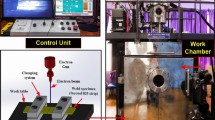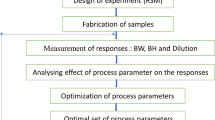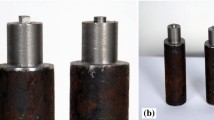Abstract
Generally, the quality of a weld joint is directly influenced by the welding parameter settings. In order to obtain a weld metal with desired weld bead quality and profile, it is necessary to adjust suitable process parameters in welding instrument. In this work, numerical and graphical optimization techniques of the electron beam welding of ultra-thin FeCo-V magnetic foils were carried out using response surface methodology (RSM) based on central composite design. The procedure was established to improve the weld strength and increase the productivity by considering the welding parameters range of beam current (0.7–1.7 mA), beam voltage (40–50 kV), welding speed (150–500 mm/min), and focused position (−20 to 0 mm). Tensile test and microhardness measurements were employed in order to study the mechanical behaviors of the welds. Moreover, microstructural observation and phase analysis were carried out in order to elucidate the change mechanism of mechanical properties in the welded area. It was found that RSM can be considered as a powerful tool in experimental welding optimization, even when the experimenter has not a model for the process. Strong, efficient, and acceptable weld joints could be achieved using the optimum welding conditions.
Similar content being viewed by others
References
Major RV, Samadian V (1989) Physical metallurgy and properties of a new high saturation Co-Fe alloy. J Mater Eng 11:27–30
Deng J, Yang Y, Wang Y, Chen J (2009) Texture evolution in heavily cold-rolled FeCo-2V alloy during annealing. J Mater Sci Technol 25:219–224
Shang C, Cammarata RC, Weihs TP, Chien CL (2000) Microstructure and Hall–Petch behavior of Fe-Co-based. J Mater Res 15:835–837
Sourmail T (2005) Comments on “Character of transformations in Fe-Co system”. pp. 1–12
Gilles R, Hofmann M, Johnson F, Gao Y, Mukherji D, Hugenschmidt C, Pikart P (2011) Analysis of antiphase domain growth in ternary FeCo alloys after different cooling rates and annealing treatments using neutron diffraction and positron annihilation. J Alloys Compd 509:195–199
Nabi B, Helbert A, Brisset F, André G, Waeckerlé T, Baudin T (2013) Effect of recrystallization and degree of order on the magnetic and mechanical properties of soft magnetic FeCo–2V alloy. Mater Sci Eng A 578:215–221
Kawahara K (1983) Effect of cold rolling on the mechanical properties of an FeCo-2V alloy. J Mater Sci 18:3437–3448
Nesbitt EA (1942) A workable alloy for permanent magnets. US Patent
Clegg DW, Buckley RA (1973) Order transformation in iron-cobalt-based alloys. Mater Sci Technol 7:48–54
White JH, Wahl CV (1932) Workable magnetic compositions containing principally iron and cobalt. US Patent
Kawahara K (1983) Effect of additive elements on cold workability in FeCo alloys. J Mater Sci 18:1709–1718
Sundar R, Deevi S (2004) Effect of heat-treatment on the room temperature ductility of an ordered intermetallic Fe–Co–V alloy. Mater Sci Eng A 369:164–169
Zakharov VM, Libman MA, Estrin EI (2012) On the role of atomic ordering in the formation of a high-coercivity state in iron-cobalt-vanadium alloys. Phys Met Metallogr 113:43–47
Pinnel M, Bennett J (1974) Correlation of magnetic and mechanical properties with microstructure in Fe/Co/2-3 pct V alloys. Metall Trans 5:1273–1283
Ustinovshikov YÃ, Lomova N, Shabanova I (2008) High-temperature B2 ordering in Fe 50 Co 50 alloy. 69:1753–1757
Sundar RS, Deevi SC (2004) Influence of alloying elements on the mechanical properties of FeCo-V alloys
Couto AA, Ferreira PI (1989) Phase transformations and properties of Fe-Co alloys. J Mater Eng 11:31–36
George E, Gubbi A, Baker I, Robertson L (2002) Mechanical properties of soft magnetic FeCo alloys. Mater Sci Eng A 331:325–333
Zhu F, Bi X, Zhang S, Gong S, Xu H (2004) Phase transformation and magnetic properties of annealed Fe52.2Co46V1.8 alloy. Vacuum 75:33–38
Díaz-Ortiz A, Drautz R, Fähnle M (2006) Structure and magnetism in bcc-based iron-cobalt alloys. Phys Rev B 73:224208,1–224208,15
Chamanfar A, Jahazi M, Bonakdar A, Morin E, Firoozrai A (2015) Cracking in fusion zone and heat affected zone of electron beam welded Inconel-713LC gas turbine blades. Mater Sci Eng A 642:230–240
Huiqiang WU, Jicai F, Jingshan HE (2004) Microstructure evolution and fracture behaviour for electron beam welding of Ti – 6Al – 4V. 27:387–392
Zhang B, Li X, Wang T, Wang X (2015) Microstructure and corrosion behavior of Zr-702 joined by electron beam welding. Vacuum
Koleva E (2001) Statistical modelling and computer programs for optimisation of the electron beam welding of stainless steel. Vacuum 62:151–157
Montgomery DC (2001) Design and analysis of experiments. Wiley, New York
Duckham A, Zhang D, Liang D, Luzin V, Cammarata R, Leheny R, Chien C, Weihs T (2003) Temperature dependent mechanical properties of ultra-fine grained FeCo–2V. Acta Mater 51:4083–4093
Kou S (2003) Welding metallurgy
Buckley RA (1975) Microstructure and kinetics of the ordering transformation in iron-cobalt alloys. p. 4–8
Khan I (2007) Welding science and technology. New Age International, New Delhi
Turgut Z, Huang M, Horwath JC, Fingers RT (2008) High strength bulk Fe–Co alloys produced by powder metallurgy. J Appl Phys 103:07E724,1–07E724,3
Tzeng Y (2000) Parametric analysis of the pulsed Nd: YAG laser seam-welding process. J Mater Process Technol 102:40–47
Song YG, Li WS, Li L, Zheng YF (2008) The influence of laser welding parameters on the microstructure and mechanical property of the as-jointed NiTi alloy wires. Mater Lett 62:2325–2328
Hazratinezhad M, Mostafa Arab NB, Sufizadeh AR, Torkamany MJ (2012) Mechanical and metallurgical properties of pulsed neodymium-doped yttrium aluminum garnet laser welding of dual phase steels. Mater Des 33:83–87
Malekghaini F, Hamedi M, Torkamany M, Sabbaghzadeh J (2007) Weld metal microstructural characteristics in pulsed Nd: YAG laser welding. Scr Mater 56:955–958
Zhao X, Liu Y (2014) Research on fatigue behavior of electron beam welding joint of 06Cr19Ni10 austenitic stainless steel sheet. Mater Des 57:494–502
Koleva E, Vuchkov I (2005) Model-based approach for quality improvement of electron beam welding applications in mass production. Vacuum 77:423–428
Yi S, Su Y, Qi B, Su Z, Wan Y (2010) Application of response surface methodology and central composite rotatable design in optimizing the preparation conditions of vinyltriethoxysilane modified silicalite/polydimethylsiloxane hybrid pervaporation membranes. Sep Purif Technol 71:252–262
Landau L (1937) Probability and statistic. Zhurnal Eksperimental’noi i Teoreticheskoi Fiziki
Blondeau R (2013) Metallurgy and mechanics of welding. Wiley, Hobokon
Ho CY (2005) Fusion zone during focused electron-beam welding. J Mater Process Technol 167:265–272
Koleva E (2005) Electron beam weld parameters and thermal efficiency improvement. Vacuum 77:413–421
Acherjee B, Misra D, Bose D, Venkadeshwaran K (2009) Prediction of weld strength and seam width for laser transmission welding of thermoplastic using response surface methodology. Opt Laser Technol 41:956–967
Author information
Authors and Affiliations
Corresponding author
Rights and permissions
About this article
Cite this article
Mostaan, H., Shamanian, M. & Safari, M. Process analysis and optimization for fracture stress of electron beam welded ultra-thin FeCo-V foils. Int J Adv Manuf Technol 87, 1045–1056 (2016). https://doi.org/10.1007/s00170-016-8553-0
Received:
Accepted:
Published:
Issue Date:
DOI: https://doi.org/10.1007/s00170-016-8553-0




